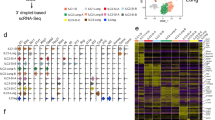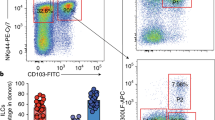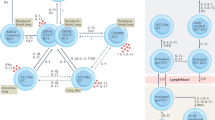Abstract
Recent studies have identified distinct subsets of innate lymphocytes, collectively called innate lymphoid cells (ILCs), which lack antigen receptor expression but produce various effector cytokines. Group 2 ILCs (ILC2s) respond to epithelial cell–derived cytokines such as interleukin (IL)-25, IL-33 and thymic stromal lymphopoietin (TSLP), produce large amounts of type 2 cytokines, and have a key role in anti-helminth innate immunity and in the pathophysiology of allergic inflammation. The reported phenotypic characteristics of mouse ILC2s vary, depending on the tissue source and preparation method. This protocol describes improved methods for tissue-specific isolation and analysis of mouse ILC2s of high purity and yield from fat tissue, lung, bronchoalveolar lavage fluid (BALF) and small intestine. These improved methods are the result of our thorough investigation of enzymes used for tissue digestion, methods for the elimination of undesired cells, and a combination of antibodies for the detection and isolation of ILC2s. In addition, this new protocol now enables the isolation of ILC2s of high yield, even from inflamed tissues. Depending on the tissue being analyzed, it takes ∼2–4 h for isolation and flow cytometric analysis of ILC2s from the various tissues of a single mouse and ∼4–8 h to sort purified ILC2s from pooled tissues of multiple mice.
This is a preview of subscription content, access via your institution
Access options
Subscribe to this journal
Receive 12 print issues and online access
$259.00 per year
only $21.58 per issue
Buy this article
- Purchase on Springer Link
- Instant access to full article PDF
Prices may be subject to local taxes which are calculated during checkout






Similar content being viewed by others
References
Koyasu, S. & Moro, K. Role of innate lymphocytes in infection and inflammation. Front. Immunol. 3, 101 (2012).
Spits, H. & Cupedo, T. Innate lymphoid cells: emerging insights in development, lineage relationships, and function. Annu. Rev. Immunol. 30, 647–675 (2012).
Spits, H. & Di Santo, J.P. The expanding family of innate lymphoid cells: regulators and effectors of immunity and tissue remodeling. Nat. Immunol. 12, 21–27 (2011).
Spits, H. et al. Innate lymphoid cells—a proposal for uniform nomenclature. Nat. Rev. Immunol. 13, 145–149 (2013).
Eberl, G. Immunology: close encounters of the second type. Nature 464, 1285–1286 (2010).
Holgate, S.T. Innate and adaptive immune responses in asthma. Nat. Med. 18, 673–683 (2012).
Kim, B.S., Wojno, E.D. & Artis, D. Innate lymphoid cells and allergic inflammation. Curr. Opin. Immunol. 25, 738–744 (2013).
Koyasu, S. & Moro, K. Type 2 innate immune responses and the natural helper cell. Immunology 132, 475–481 (2011).
Koyasu, S., Moro, K., Tanabe, M. & Takeuchi, T. Natural helper cells: a new player in the innate immune response against helminth infection. Adv. Immunol. 108, 21–44 (2010).
Licona-Limon, P., Kim, L.K., Palm, N.W. & Flavell, R.A. TH2, allergy and group 2 innate lymphoid cells. Nat. Immunol. 14, 536–542 (2013).
Moro, K. et al. Innate production of TH2 cytokines by adipose tissue-associated c-Kit+Sca-1+ lymphoid cells. Nature 463, 540–544 (2010).
Paul, W.E. & Zhu, J. How are TH2-type immune responses initiated and amplified? Nat. Rev. Immunol. 10, 225–235 (2010).
Halim, T.Y., Krauss, R.H., Sun, A.C. & Takei, F. Lung natural helper cells are a critical source of TH2 cell-type cytokines in protease allergen-induced airway inflammation. Immunity 36, 451–463 (2012).
Halim, T.Y. et al. Group 2 innate lymphoid cells are critical for the initiation of adaptive T helper 2 cell-mediated allergic lung inflammation. Immunity 40, 425–435 (2014).
Kabata, H. et al. Thymic stromal lymphopoietin induces corticosteroid resistance in natural helper cells during airway inflammation. Nat. Commun. 4, 2675 (2013).
Motomura, Y. et al. Basophil-derived interleukin-4 controls the function of natural helper cells, a member of ILC2s, in lung inflammation. Immunity 40, 758–771 (2014).
Kim, H.Y. et al. Innate lymphoid cells responding to IL-33 mediate airway hyperreactivity independently of adaptive immunity. J. Allergy Clin. Immunol. 129, 216–227 (2012).
Chang, Y.J. et al. Innate lymphoid cells mediate influenza-induced airway hyper-reactivity independently of adaptive immunity. Nat. Immunol. 12, 631–638 (2011).
Huang, Y. et al. IL-25-responsive, lineage-negative KLRG1hi cells are multipotential ′inflammatory′ type 2 innate lymphoid cells. Nat. Immunol. 16, 161–169 (2015).
Furusawa, J. et al. Critical role of p38 and GATA3 in natural helper cell function. J. Immunol. 191, 1818–1826 (2013).
Halim, T.Y. & Takei, F. Isolation and characterization of mouse innate lymphoid cells. Curr. Protoc. Immunol. 106, 3.25.1–3.25.13 (2014).
Hoyler, T. et al. The transcription factor GATA-3 controls cell fate and maintenance of type 2 innate lymphoid cells. Immunity 37, 634–648 (2012).
Sanos, S.L. & Diefenbach, A. Isolation of NK cells and NK-like cells from the intestinal lamina propria. Methods Mol. Biol. 612, 505–517 (2010).
Neill, D.R. et al. Nuocytes represent a new innate effector leukocyte that mediates type-2 immunity. Nature 464, 1367–1370 (2010).
Price, A.E. et al. Systemically dispersed innate IL-13-expressing cells in type 2 immunity. Proc. Natl. Acad. Sci. USA 107, 11489–11494 (2010).
Caesar, R. & Drevon, C.A. Pancreatic contamination of mesenteric adipose tissue samples can be avoided by adjusted dissection procedures. J. Lipid Res. 49, 1588–1594 (2008).
Vasanthakumar, A. et al. The transcriptional regulators IRF4, BATF and IL-33 orchestrate development and maintenance of adipose tissue-resident regulatory T cells. Nat. Immunol. 16, 276–285 (2015).
Acknowledgements
We thank M. Mochitzuki and N. Takeno for technical assistance. We also thank S. Wada, C. Yamamoto and T. Shitamichi for taking care of mice. Thanks are also due to J. Furusawa, T. Sasaki and S. Koga for helpful advice and discussions. This work was supported by PRESTO to K.M. from the Japan Science and Technology Agency; a Grant-in Aid for Scientific Research (B) (26293110) and a Grant-in-Aid for Challenging Exploratory Research (24659373) to K.M.; a Grant-in-Aid for Scientific Research (S) (22229004) and a Grant-in-Aid for Challenging Exploratory Research (25670235) to S.K. from the Japan Society for the Promotion of Science; a Grant-in-Aid for Scientific Research on Innovative Areas (23118526 and 15H01166) to K.M. from the Ministry of Education, Culture, Sports, Science and Technology, Japan; and grants from The Nakajima Foundation and Mochida Memorial Foundation for Medical and Pharmaceutical Research to K.M.
Author information
Authors and Affiliations
Contributions
K.M. and H.K. designed the protocols; K.M. and K.N.E. analyzed the results; and K.M., K.N.E. and S.K. wrote the manuscript.
Corresponding author
Ethics declarations
Competing interests
S.K. is a consultant for Medical and Biological Laboratories Co., Ltd. All other authors declare no competing financial interests.
Integrated supplementary information
Supplementary Figure 1 Stepwise procedure for opening the mouse abdominal cavity.
(a) Make a midline incision on the surface of the abdominal cavity. (b) Using hands, pull the skin to expose the abdominal cavity. Make a vertical cut through the skin. (c-d) Make 4 diagonal cuts along the abdominal cavity to expose the intestines. The blue arrows indicate the direction of the incisions.
Supplementary information
Rights and permissions
About this article
Cite this article
Moro, K., Ealey, K., Kabata, H. et al. Isolation and analysis of group 2 innate lymphoid cells in mice. Nat Protoc 10, 792–806 (2015). https://doi.org/10.1038/nprot.2015.047
Published:
Issue Date:
DOI: https://doi.org/10.1038/nprot.2015.047
This article is cited by
-
Vitamin B6 regulates IL-33 homeostasis to alleviate type 2 inflammation
Cellular & Molecular Immunology (2023)
-
Activation of ILC2s through constitutive IFNγ signaling reduction leads to spontaneous pulmonary fibrosis
Nature Communications (2023)
-
GRK2 regulates group 2 innate lymphoid cell mobilization in sepsis
Molecular Medicine (2022)
-
IL-22 initiates an IL-18-dependent epithelial response circuit to enforce intestinal host defence
Nature Communications (2022)
-
Upregulation of leukocyte immunoglobulin-like receptor B4 on interstitial macrophages in COPD; their possible protective role against emphysema formation
Respiratory Research (2021)
Comments
By submitting a comment you agree to abide by our Terms and Community Guidelines. If you find something abusive or that does not comply with our terms or guidelines please flag it as inappropriate.



